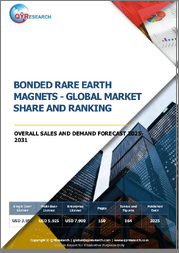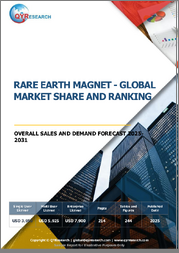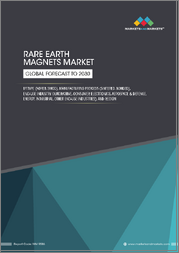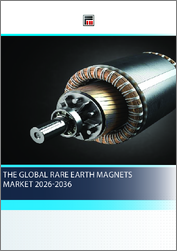
|
시장보고서
상품코드
1658178
희토류 자석 시장 규모, 점유율, 성장 분석 : 자석 유형별, 용도별, 지역별 - 산업 예측(2025-2032년)Rare Earth Magnet Market Size, Share, and Growth Analysis, By Magnet Type (Neodymium-Iron-Boron (NdFeB) Magnets, Samarium-Cobalt (SmCo) Magnets), By Application (NdFeB Magnets, SmCo Magnets), By Region - Industry Forecast 2025-2032 |
||||||
희토류 자석 시장 규모는 2023년 185억 3,000만 달러로 평가되었습니다. 2024년 196억 달러에서 2032년 307억 8,000만 달러로 성장할 것으로 예상되며, 예측 기간(2025-2032년) 동안 5.8%의 연평균 복합 성장률(CAGR)을 보일 전망입니다.
세계 희토류 금속 시장은 전자, 청정 에너지 등 다양한 분야의 첨단 기술 제조에 필수적인 다양한 요인으로 인해 큰 변화를 겪고 있습니다. 지정학적 긴장으로 인해 공급망의 취약성에 대한 인식이 높아지면서 정부와 기업 모두 다각화 및 자원 개발 전략의 강화를 요구하고 있습니다. 또한, 환경 문제에 대한 관심이 높아지면서 산업 규제에 영향을 미치고, 지속 가능한 채굴 관행과 책임 있는 조달에 대한 중요성이 강조되고 있습니다. 세계가 점점 더 전기화 및 첨단 기술로 나아감에 따라 희토류 자석에 대한 수요는 증가할 것으로 예상되며, 공급과 환경적 책임 사이의 신중한 균형이 필요합니다. 이러한 변화하는 상황은 희토류 자석 시장의 이해관계자들에게 지속가능성과 지정학적 역학의 복잡성을 헤쳐 나가야 하는 기회와 도전을 제시하고 있습니다.
목차
서론
- 조사 목적
- 조사 범위
- 정의
조사 방법
- 정보 조달
- 2차와 1차 데이터 방법
- 시장 규모 예측
- 시장 전제조건과 제한
주요 요약
- 세계 시장 전망
- 공급과 수요 동향 분석
- 부문별 기회 분석
시장 역학과 전망
- 시장 개요
- 시장 규모
- 시장 역학
- 성장 촉진요인과 기회
- 성장 억제요인과 과제
- Porter의 Five Forces 분석
주요 시장 인사이트
- 중요 성공 요인
- 경쟁 정도
- 주요 투자 기회
- 시장 생태계
- 시장의 매력 지수(2024년)
- PESTEL 분석
- 거시경제 지표
- 밸류체인 분석
- 가격 분석
- 원재료 분석
희토류 자석 시장 규모 : 자석 유형별&CAGR(2025-2032년)
- 시장 개요
- 네오디뮴 철 붕소(NdFeB) 자석
- 사마륨 코발트(SmCo) 자석
희토류 자석 시장 규모 : 용도별&CAGR(2025-2032년)
- 시장 개요
- NdFeB 자석
- 자동차
- 일렉트로닉스
- 발전기
- 의료 업계
- 풍력
- 기타
- SmCo 자석
- 방위
- 항공우주
- 일렉트로닉스
- 의료기기
- 기타
희토류 자석 시장 규모 : 지역별&CAGR(2025-2032년)
- 북미
- 미국
- 캐나다
- 유럽
- 독일
- 스페인
- 프랑스
- 영국
- 이탈리아
- 기타 유럽
- 아시아태평양
- 중국
- 인도
- 일본
- 한국
- 기타 아시아태평양
- 라틴아메리카
- 브라질
- 기타 라틴아메리카
- 중동 및 아프리카
- GCC 국가
- 남아프리카공화국
- 기타 중동 및 아프리카
경쟁 정보
- 주요 5개사 비교
- 주요 기업의 시장 포지셔닝(2024년)
- 주요 시장 기업이 채택한 전략
- 최근 시장 동향
- 기업의 시장 점유율 분석(2024년)
- 주요 기업 개요
- 기업 상세
- 제품 포트폴리오 분석
- 기업 부문별 점유율 분석
- 전년대비 매출 비교(2022-2024년)
주요 기업 개요
- MP Materials Corp.(United States)
- Lynas Rare Earths Ltd.(Australia)
- China Northern Rare Earth Group High-Tech Co., Ltd.(China)
- Shenghe Resources Holding Co., Ltd.(China)
- Neo Performance Materials Inc.(Canada)
- Hitachi Metals, Ltd.(Japan)
- Shin-Etsu Chemical Co., Ltd.(Japan)
- Beijing Zhong Ke San Huan Hi-Tech Co., Ltd.(China)
- Vacuumschmelze GmbH & Co. KG(Germany)
- Arnold Magnetic Technologies(United States)
- Adams Magnetic Products Co.(United States)
- Energy Fuels Inc.(United States)
- Iluka Resources Limited(Australia)
- Arafura Rare Earths Limited(Australia)
- Avalon Advanced Materials Inc.(Canada)
- USA Rare Earth, LLC(United States)
- China Minmetals Rare Earth Co., Ltd.(China)
- Indian Rare Earths Limited(India)
- LG Innotek Co., Ltd.(South Korea)
- ERGA(Russia)
결론과 제안
LSH 25.03.28Rare Earth Magnet Market size was valued at USD 18.53 billion in 2023 and is poised to grow from USD 19.6 billion in 2024 to USD 30.78 billion by 2032, growing at a CAGR of 5.8% during the forecast period (2025-2032).
The global rare earth metals market is undergoing significant transformation, driven by diverse factors critical to high-tech manufacturing across sectors like electronics and clean energy. Geopolitical tensions have heightened awareness of supply chain vulnerabilities, leading both governments and businesses to seek diversification and enhanced resource development strategies. Furthermore, rising environmental concerns are influencing industry regulations, emphasizing sustainable mining practices and responsible sourcing. As the world increasingly moves towards electrification and advanced technologies, the demand for rare earth metals is expected to escalate, necessitating a careful balance between supply and environmental responsibility. This evolving landscape presents opportunities and challenges for stakeholders in the rare earth metals market as they navigate the complexities of sustainability and geopolitical dynamics.
Top-down and bottom-up approaches were used to estimate and validate the size of the Rare Earth Magnet market and to estimate the size of various other dependent submarkets. The research methodology used to estimate the market size includes the following details: The key players in the market were identified through secondary research, and their market shares in the respective regions were determined through primary and secondary research. This entire procedure includes the study of the annual and financial reports of the top market players and extensive interviews for key insights from industry leaders such as CEOs, VPs, directors, and marketing executives. All percentage shares split, and breakdowns were determined using secondary sources and verified through Primary sources. All possible parameters that affect the markets covered in this research study have been accounted for, viewed in extensive detail, verified through primary research, and analyzed to get the final quantitative and qualitative data.
Rare Earth Magnet Market Segments Analysis
Global Rare Earth Magnet Market is segmented by Magnet Type, Application and region. Based on Magnet Type, the market is segmented into Neodymium-Iron-Boron (NdFeB) Magnets and Samarium-Cobalt (SmCo) Magnets. Based on Application, the market is segmented into NdFeB Magnets and SmCo Magnets. Based on region, the market is segmented into North America, Europe, Asia Pacific, Latin America and Middle East & Africa.
Driver of the Rare Earth Magnet Market
A significant driving force behind the global rare earth magnet market is the continuous advancements in technology. Rare earth metals possess unique characteristics that are essential for the production of advanced electronics, renewable energy solutions, and defense systems. As industries strive for innovation and the creation of more efficient, compact components, the requirement for rare earth metals escalates. Additionally, ongoing research and development initiatives aim to broaden the spectrum of applications for these critical elements, further amplifying their demand in the global marketplace. This interplay of technological evolution and expanding use cases positions rare earth metals as pivotal to modern advancements.
Restraints in the Rare Earth Magnet Market
A significant challenge confronting the rare earth magnet market stems from escalating environmental concerns alongside a strong emphasis on sustainability. The processes involved in extracting and refining rare earth metals frequently lead to detrimental environmental impacts, including the generation of toxic waste and disruption of natural habitats. As global awareness of these environmental issues intensifies, regulatory frameworks and consumer demand are increasingly advocating for more sustainable and eco-friendly production methodologies. This shift toward greener practices not only elevates the costs associated with rare earth production but also complicates the supply chains involved, ultimately restraining market growth and innovation in the sector.
Market Trends of the Rare Earth Magnet Market
A significant market trend in the rare earth magnet sector is the shift towards sustainable and responsible sourcing, spurred by rising environmental consciousness and ethical concerns among consumers and regulators. Companies are increasingly prioritizing eco-friendly mining practices and responsible processing methods to mitigate environmental impact and promote fair labor standards within their supply chains. This shift is redefining competitive advantage, compelling market players to invest in transparency and traceability initiatives that align with evolving consumer preferences for responsibly sourced materials. As these sustainable practices become integral to operations, they not only enhance brand value but also contribute to long-term industry resilience and compliance.
Table of Contents
Introduction
- Objectives of the Study
- Scope of the Report
- Definitions
Research Methodology
- Information Procurement
- Secondary & Primary Data Methods
- Market Size Estimation
- Market Assumptions & Limitations
Executive Summary
- Global Market Outlook
- Supply & Demand Trend Analysis
- Segmental Opportunity Analysis
Market Dynamics & Outlook
- Market Overview
- Market Size
- Market Dynamics
- Drivers & Opportunities
- Restraints & Challenges
- Porters Analysis
- Competitive rivalry
- Threat of substitute
- Bargaining power of buyers
- Threat of new entrants
- Bargaining power of suppliers
Key Market Insights
- Key Success Factors
- Degree of Competition
- Top Investment Pockets
- Market Ecosystem
- Market Attractiveness Index, 2024
- PESTEL Analysis
- Macro-Economic Indicators
- Value Chain Analysis
- Pricing Analysis
- Raw Material Analysis
Global Rare Earth Magnet Market Size by Magnet Type & CAGR (2025-2032)
- Market Overview
- Neodymium-Iron-Boron (NdFeB) Magnets
- Samarium-Cobalt (SmCo) Magnets
Global Rare Earth Magnet Market Size by Application & CAGR (2025-2032)
- Market Overview
- NdFeB Magnets
- Automobile
- Electronics
- Power Generators
- Medical Industry
- Wind Power
- Others
- SmCo Magnets
- Defense
- Aerospace
- Electronics
- Medical Devices
- Others
Global Rare Earth Magnet Market Size & CAGR (2025-2032)
- North America (Magnet Type, Application)
- US
- Canada
- Europe (Magnet Type, Application)
- Germany
- Spain
- France
- UK
- Italy
- Rest of Europe
- Asia Pacific (Magnet Type, Application)
- China
- India
- Japan
- South Korea
- Rest of Asia-Pacific
- Latin America (Magnet Type, Application)
- Brazil
- Rest of Latin America
- Middle East & Africa (Magnet Type, Application)
- GCC Countries
- South Africa
- Rest of Middle East & Africa
Competitive Intelligence
- Top 5 Player Comparison
- Market Positioning of Key Players, 2024
- Strategies Adopted by Key Market Players
- Recent Developments in the Market
- Company Market Share Analysis, 2024
- Company Profiles of All Key Players
- Company Details
- Product Portfolio Analysis
- Company's Segmental Share Analysis
- Revenue Y-O-Y Comparison (2022-2024)
Key Company Profiles
- MP Materials Corp. (United States)
- Company Overview
- Business Segment Overview
- Financial Updates
- Key Developments
- Lynas Rare Earths Ltd. (Australia)
- Company Overview
- Business Segment Overview
- Financial Updates
- Key Developments
- China Northern Rare Earth Group High-Tech Co., Ltd. (China)
- Company Overview
- Business Segment Overview
- Financial Updates
- Key Developments
- Shenghe Resources Holding Co., Ltd. (China)
- Company Overview
- Business Segment Overview
- Financial Updates
- Key Developments
- Neo Performance Materials Inc. (Canada)
- Company Overview
- Business Segment Overview
- Financial Updates
- Key Developments
- Hitachi Metals, Ltd. (Japan)
- Company Overview
- Business Segment Overview
- Financial Updates
- Key Developments
- Shin-Etsu Chemical Co., Ltd. (Japan)
- Company Overview
- Business Segment Overview
- Financial Updates
- Key Developments
- Beijing Zhong Ke San Huan Hi-Tech Co., Ltd. (China)
- Company Overview
- Business Segment Overview
- Financial Updates
- Key Developments
- Vacuumschmelze GmbH & Co. KG (Germany)
- Company Overview
- Business Segment Overview
- Financial Updates
- Key Developments
- Arnold Magnetic Technologies (United States)
- Company Overview
- Business Segment Overview
- Financial Updates
- Key Developments
- Adams Magnetic Products Co. (United States)
- Company Overview
- Business Segment Overview
- Financial Updates
- Key Developments
- Energy Fuels Inc. (United States)
- Company Overview
- Business Segment Overview
- Financial Updates
- Key Developments
- Iluka Resources Limited (Australia)
- Company Overview
- Business Segment Overview
- Financial Updates
- Key Developments
- Arafura Rare Earths Limited (Australia)
- Company Overview
- Business Segment Overview
- Financial Updates
- Key Developments
- Avalon Advanced Materials Inc. (Canada)
- Company Overview
- Business Segment Overview
- Financial Updates
- Key Developments
- USA Rare Earth, LLC (United States)
- Company Overview
- Business Segment Overview
- Financial Updates
- Key Developments
- China Minmetals Rare Earth Co., Ltd. (China)
- Company Overview
- Business Segment Overview
- Financial Updates
- Key Developments
- Indian Rare Earths Limited (India)
- Company Overview
- Business Segment Overview
- Financial Updates
- Key Developments
- LG Innotek Co., Ltd. (South Korea)
- Company Overview
- Business Segment Overview
- Financial Updates
- Key Developments
- ERGA (Russia)
- Company Overview
- Business Segment Overview
- Financial Updates
- Key Developments


















